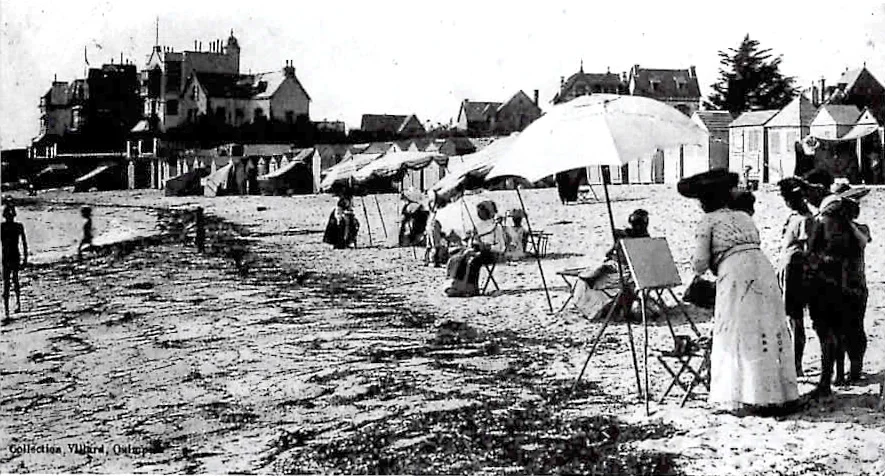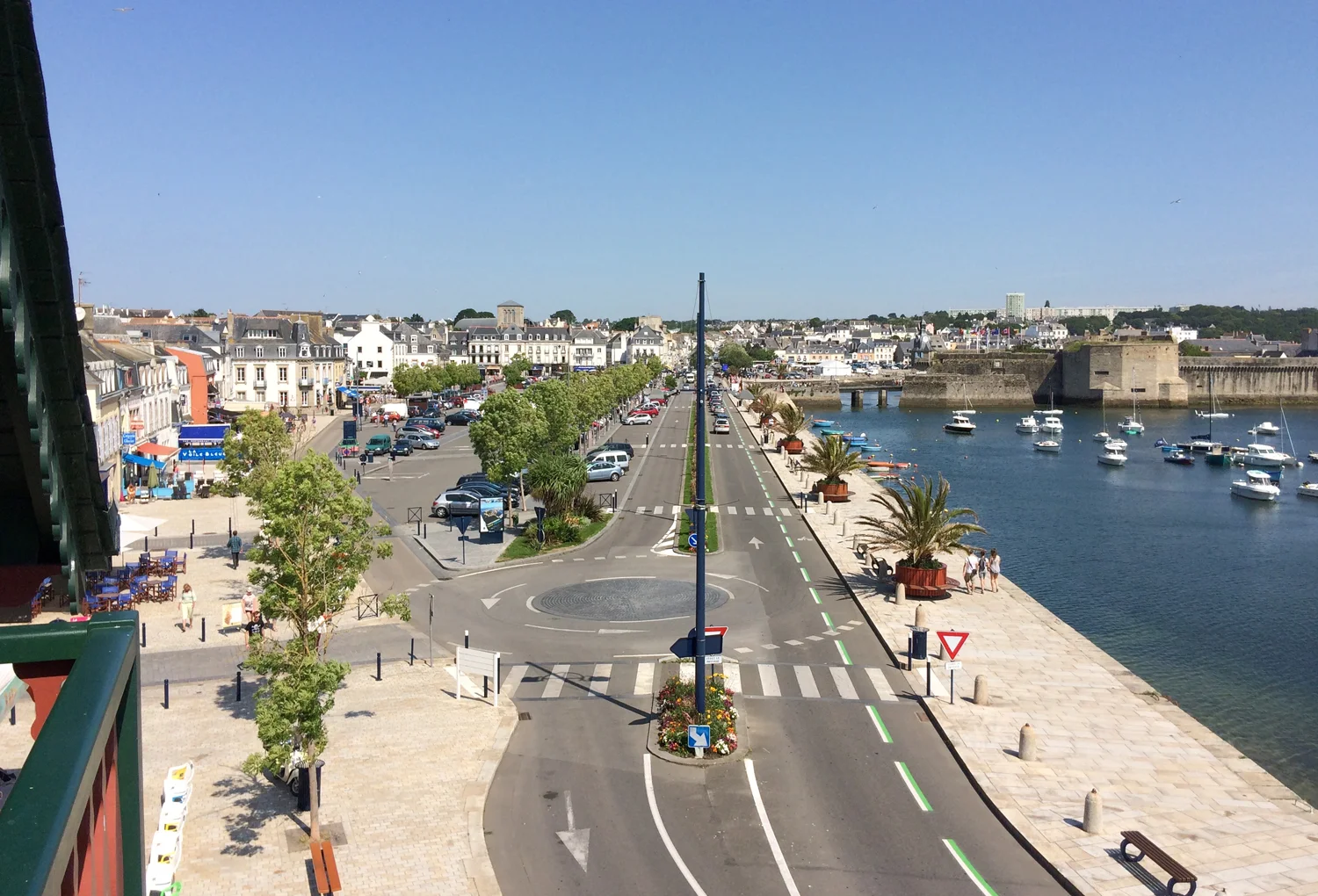THE INFLUENCE OF THE FRENCH SEASIDE
―
In the early 1900s, Frances Hodgkins took it upon herself to further her career in Europe and Britain by holding painting classes and regular exhibitions of her work. In 1908 she became one of the first female teachers at the prestigious Académie Colarossi in Paris. Hodgkins toured around Normandy and Picardy with her group of students, sketching in the villages of Concarneau, Le Havre and St Valery-sur-Somme. It was on these teaching trips that Hodgkins met and befriended some of her most loyal companions, one of the most significant of which was Jane Saunders. Hodgkins first met Saunders and her partner, Hannah Ritchie, in 1911 at Concarneau and friends such as this pair, continually supported her throughout her life.
Hodgkins continued to paint and teach, and held regular sketching classes in France until the outbreak of the First World War (1914 -1918).
Frances Hodgkins painting at Concarneau, August 1910
Courtesy of E H McCormick Library, ACAG
The same view of Concarneau Harbour, 2013
Tunny Boats in the Harbour,
Concarneau c.1910
PRIVATE COLLECTION
Tunny Boats in the Harbour, Concarneau c.1910 was painted at a pivotal time in Frances Hodgkins’s career. Between 1908 and 1912 she made a determined bid to position her art and her reputation in Paris. Besides providing a stimulating environment, France provided Hodgkins with the varied light, colours and subject matter that she wished to translate into her art.
While living in Paris, Hodgkins became inundated with requests for tutoring, and in the winter of 1909-10, against the wishes of her mother, she cancelled her return trip to New Zealand in order to teach at one of the foremost private academies in Paris: the Académie Colarossi. It is notable that Hodgkins was one of the first female artists to teach at this prestigious institution. With the coming of the summer sketching season, she moved with her class of pupils to Brittany, and eventually settled in the sheltered fishing village of Concarneau. The town was a well known, but still unspoilt haunt for artists and it attracted well-established French painters, students and amateurs alike. In this idyllic location Hodgkins found the ideal subject matter, not only for her own artwork, but also for her eager students. She later wrote of her teaching experience from Paris on the 27th of November 1911 saying:
‘My Class is a real going concern now & a great success. I am refusing pupils on account of lack of space. I can only take 16 altogether – 8 in each class as the Studio is not large. Also I have several private pupils at a guinea an hour.’
The boats and harbour of Concarneau were popular subjects for artists at the time and regularly featured in the paintings of the Fauves and the Newlyn School. It is likely that the Newlyn artist, Norman Garstin, introduced Hodgkins to Concarneau. Before arriving at Concarneau, Hodgkins had painted a number of works in Europe that featured fishing vessels - several of which can be found in the collection of the Auckland Art Gallery and the Dunedin Public Art Gallery.
HOTEL DES VOYAGEURS & THE PARISIAN PRESS
―
Hotel des Voyageurs, 2013
Frances stayed at the Hotel des Voyageurs in Concarneau from October to December 1910. It is here that she received news her work had caught the attention of the Parisian press - for the first time.
She writes to her mother in October: ‘I would send on the press notices - but they are in French. I will only give you my word for it they say I am a deuced clever woman or words to that effect.’
Grand Hotel des Voyageurs, Concarneau. c.15th October 1910
‘.... I am the only woman artist left in Concarneau.... A lot of men are turning up for the winter & settling into their studios. As I said in my last letter - I'll try & be good - if I can't be good I'll be careful - can't promise more! ... I go for walks by the sad sea walls - when it is too dark to paint - They are never sad for me I love them so & the gulls & the big sky overhead.’
Hotel des Voyageurs, Concarneau. 22nd December 1910
‘Three days till Xmas! Most glorious weather ... a whole week of it a delightful surprise like the currant in the seed cake. Camellias are blooming out of doors & i am expecting the first snowdrop to pop up any minute... I am boisterously well ... it is so much more soothing to live among simple peasants than wild eyed people of both sexes clamouring & grovelling after fame & filthy lucre ...’
IMAGE ABOVE: Hotel des Voyageurs c.1911; from an album that belonged to Hannah Ritchie • Courtesy of Alexander Turnbull Library, Wellington
Concarneau. 28th July 1910
‘I eat at a little café where I get large platefuls of soup & sardines & crabs & veal & beefsteaks very raw & red & nearly always green peas stewed with onions & lots of sugar which taste much better than they sound- all washed down with copious quantities of red wine & very sour cider…’
Still Life with Fish was painted around 1910 and is most likely to have been painted as a ‘teaching demonstration’ for one of Hodgkins’s Concarneau art classes.
In her Concarneau works, Hodgkins utilised the ‘wet-on-wet’ technique - a technique that she developed in Europe, in order to bring her watercolours to life. This method saw a flurry of line, broad washes of colour and often large expanses of untouched paper that serve to highlight the confidence of the composition and the rapidity with which these works were executed. An example of this is seen in Still Life with Fish, which possesses a vibrant immediacy as though the work has only just been finished. As a result, the work is palpably real and is a supreme example of Hodgkins’s skill at capturing fleeting moments in time.
Hodgkins’s focus on the independent forms of the serving utensils and fish combines to produce an almost abstract patterned effect. Combined with her use of multiple viewpoints and tilting planes, the watercolour acknowledges the two-dimensional reality of the paper and in doing so pays homage to the father of modern art and the abstracted still life: Paul Cézanne.
Frances' class at Le Plage des Sables-Blancs, c.1910
Editions Villard Quimper
Le Plage des Sables-Blancs (now known as Plage de Cornouailles), Concarneau 2013
THE ATLANTIC HOTEL & SYDNEY LOUGH THOMPSON'S STUDIO
―
Frances stayed at the L'Atlantic Hotel on Quai Peneroff in the summer of 1914 during which she was ‘giving 2 lessons a day’. The stay was short-lived due to the outbreak of the First World War.
She writes to her mother 29th July 1914: ‘...we are all perturbed & anxious over the war alarms & feel that any moment things may happen & we may have to disperse.’
The L'Atlantic Hotel next to Sydney Lough Thompson's green and red timbered studio, Concarneau 2013
The building on the right of the L'Atlantic Hotel was once the residence and studio of fellow expatriate artist Sydney Lough Thompson.
Thompson relocated to Concarneau in 1913 with his wife Ethel. From 1921 he rented the second and third floors of the timbered building next to the L'Atlantic Hotel from the French painter & ceramicist Théophile Deyrolle, who became a close friend. From there Thompson could observe the daily bustle of the port, which became a favourite subject for the artist until 1933 when the family made the decision to return to New Zealand. When Thompson returned to the village in 1937 he found himself disenchanted. The modernisation of the small fishing village and the absence of the sardine and tunny boats that once filled the harbour had done away with Concarneau's ‘irresistible picturesqueness’*. Thompson's dismay caused him to change his artistic focus to the land and the painting of the churches and farmyards that dominate his later works.
* Thompson, S.L. Pictures of Brittany and Provence, Armagh Street Gallery, Christchurch, 1934
IMAGE ABOVE: L'Atlantic Hotel c.1910 • Editions Villard Quimper
View from Sydney Lough Thompson's studio balcony, Concarneau 2013; the once "bustling" port can be seen right beneath the old fortifications, and the local market continues to be held at the carpark seen left
Sydney Lough Thompson
Drying Sails, Tunny Boats in Concarneau Harbour
PRIVATE COLLECTION
FRANCES REacts to THE OUTBREAK OF WORLD WAR ONE in letters to her mother
―
Atlantic-Hotel, Concarneau. 29th July 1914
‘... As artists we all feel our present insignificance in the scheme of things. Why work? Who wants it? Who cares? England is working passionately for peace & if only Time can be gained War may yet be averted, or rather localised. All this talk of Peace & here we are at each other's throats. What a little distance we have advanced in civilisation really - the more we change the more we are the same.’
Atlantic-Hotel, Concarneau. 31st July 1914
‘... It's impossible even to dream what may happen. The world has never before been faced by such a calamity - it confounds us all.’
Concarneau. 4th August 1914
‘My Dearest Mother,
This is a record of events in Concarneau since the Declaration of War on Sat. 1st Aug.
Saturday was a day of suspense and agitation. Nobody could work. We hung round the Mairie and Port Office waiting for news. Being Saturday the Port was full of fishermen, all very drunk. About 5 the town crier announced the fateful news we were all waiting for-Declaration of War by Germany and General Mobilisation of the French Army.
... Since Sunday - two days ago, no news from the outside world - gloom deeper than the deepest has settled on us - no letters, no papers, rain in torrents our beautiful tunnyboats "all gone like butterflies" ...’
REFERENCE | Linda Gill (ed.), Letters of Frances Hodgkins, Auckland University Press, 1993













